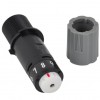Hi everyone. It's Verity here from Pretty Little Button bringing you another project. Today I've created a card using the All Occasions Patterned Paper pad from Graphtec and used it with the Silhouette PixScan Mat. The PixScan mat is a great way to get more from patterned paper other than to cut it up to create a mat layer for backgrounds. Instead, use your PixScan mat to cut out elements to create as focal elements to your papercrafts. It is so easy to do!
Getting more out of patterned paper cards detail:
To start off, you will need to calibrate your phone or camera to use the PixScan mat. Open the Pixscan window and select 'Show Calibration Test Card'. This will change the your desing window to have an 8.5 X 11" screen full of dots. Send this to print.
You need to take a picture of this print out, making sure the dots fill the whole screen on your camera. Next, transfer your photo onto the computer and load into the softwared. To do this,click on the little '+' sign in the Pixscan window and locate your photo file. Now you will have your camera listed in the window above.
It is now time to take a picture of your patterned paper to load into the software. Trim down the paper to the area you want and adhere to your PixScan mat. Now take a picture of your PixScan mat, making you can see all the mat, not just the patterned paper. It doesn't need to fill the screen like the calibration print out did. Once you have your photo, load it onto your computer.
To add the photo into the studio, select your camera/phone from the list in the PixScan Mat. I took mine on my Samsung phone. As you can see, I have my 'Samsung' calibration selected. The press I'Import PixScan Image from file'. The studio will attempt to load the picture.
When this is successful the software will load your patterned paper (or whatever else you had on your PixScan mat) into the design window, with a PixScan mat around it.
If you were unsuccessful and it the software is unable to load the photo, this will often be due to poor light of your PixScan mat when you took the photo, or the photo quality is poor. The best thing to do is to take another photo in better light and load this into the software.
In order to cut items from the patterned paper you will find the trace tool will be your best friend. I initially trace the whole mat using the trace by colour tool. All the butterflies on the paper are the same colour so this was an easy way. I altered the 'tolerance until I was happy with the 'yellow trace'.
To make it easy to see, I changed the line colour of my traced elements to blue - this stood out more from the background compared to red.
As this has also added tracelines for all the insides of the butterflies, I need to work out a way to remove this. I only want to cut around the butterfly. To do this, I selected all the items, and release compound path. This create a lot of individual cut lines.
I selected a few butterflies to cut, and removed the inner cut lines, keep the outline cut line visible.
If like me, you deleted all the other lines from the butterflies, but then decided you wanted one more butterfly, then try out the trace area and trace by colour tool together! First of all, use the 'Trace area' tool to create a little box around one butterfly you wish to trace. The in the Trace window tool, click on the 'Trace by colour' tab. Using the dropper, select the butterfly colour in your 'trace area' and manipulate the tolerance like you did previously. Due the trace area, only the colour within that box will be traced, as opposed to the whole photo as before.
To cut around the butterfly, I used the offset tool to add a small offset and once complete deleted the outline cut line.
When you have all the items traced and ready to cut, load your PixScan mat into your machine and send to cut. Remember to do a test cut first. Also the PixScan mat is very similar to print and cut - it will need to register the 'registration' marks on the mat. Make sure you have could lighting over the blade, and it need be manually align your blade over the top black square and manually register the mat.
Getting more out of patterned paper finished photos:
To assemble these cards, I added Tattered Rose and Picked Raspberry distress oxides to two card panels. Onces I was happy with the blending I added a few drops of water, left it for 20-30 second before soaking up with a kitchen towel for a distress look.
Next, I foam mounted the wings of the butterflies onto the card, applying glue beneath their bodies for dimension.
To create the sentiments, I cut the word 'Happy' and 'Hello' three times using my cameo. This font is SNF Miss Molly by ScrapNFonts. These word die cuts were layered up with glue and several layers of Pink Champagne embossing powder was added for a metallic finish.
The sentiments were added to the card panel, along with a few colour corresponding gems. The whole card panels were foam mounted onto side folding A6 card bases.
If this has inspired you to try this out, please post below. I would love to see it!
Until next time,
Verity

Profile | Pretty Little Button Blog | Instagram | Facebook
SNF Miss Molly by ScrapNfonts -Design ID #8759
PRODUCTS USED:

















No comments:
Post a Comment